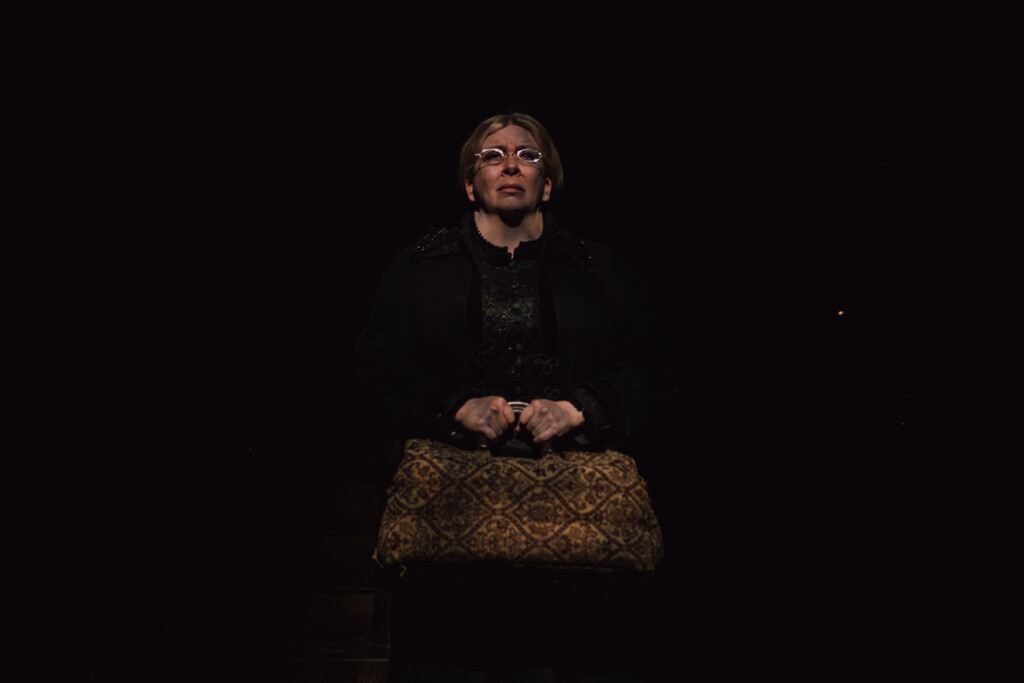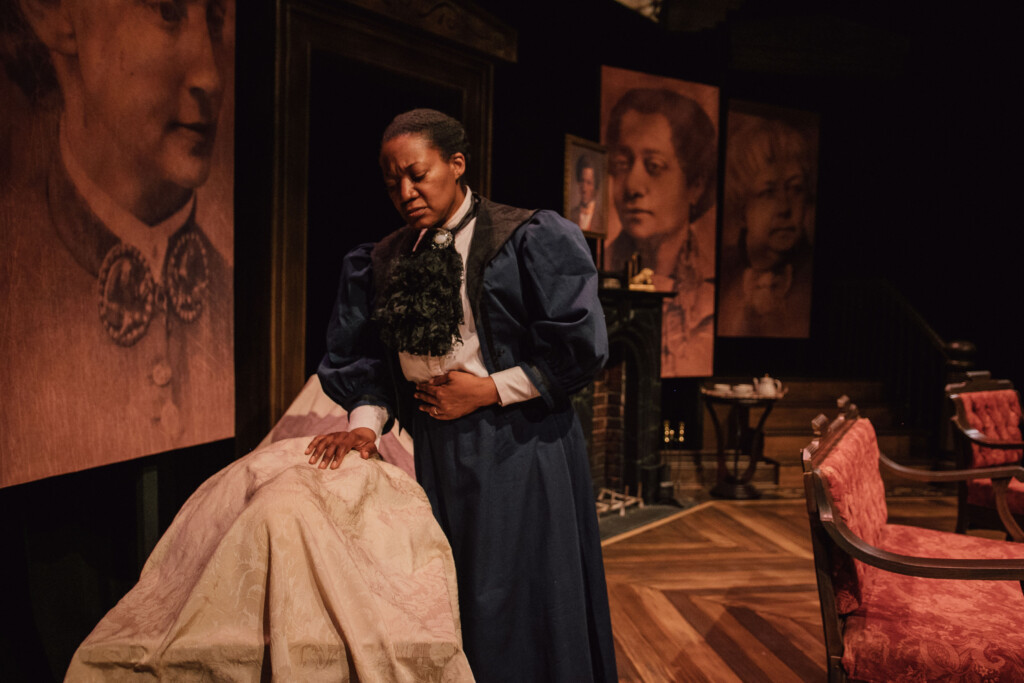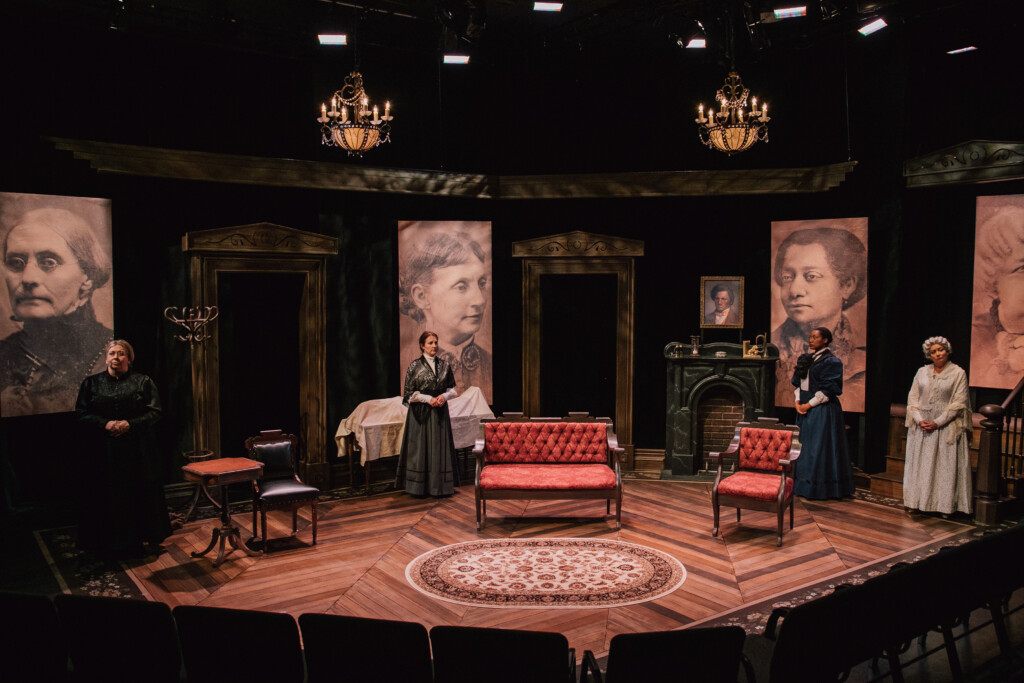Justin Ivie’s consummate set design for Salt Lake Acting Company’s (SLAC) world premiere production of Elaine Jarvik’s Four Women Talking About the Man Under the Sheet highlights large banner portraits of the four historical characters and the smaller portrait of Frederick Douglass. The shrouded body of Douglass lies in repose on a bier in the home. The visual effect is of a pantheon but as the play unfolds with Helen, Douglass’s widow (Susanna Florence); Rosetta, his daughter (Yolanda Stange) and two of the most well-known suffragists of the 19th century, Susan B. Anthony (Colleen Baum) and Elizabeth Cady Stanton (Tamara Howell), the story steers clear from hero worship or hagiography. Writing about the “great schism” between suffragists and abolitionists of the time, Ta-Nehisi Coates explained, “ I don’t need my personal pantheon to be clean. But I need it to be filled with warriors.”
Jarvik orchestrates an elegant historical case lesson that resonates with Coates’s sentiment in her exceptional script. Commendably, especially in the historical scenes portrayed, the five actors make SLAC’s 50th season opener a stellar addition to the canon of The Utah Enlightenment. The production, co-directed by Martine Kei Green-Rogers and Jason Bowcutt, continues with performances through the end of this month.
The play opens in the late winter of 1895, the day after Frederick Douglass has died, when Susan B. Anthony appears to offer her condolences to Helen, his widow. The play has one additional character who has no specific historical details as her foundation but she also anchors the most significant epiphany of Jarvik’s script. Zoe (Latoya Cameron) is directing, as Jarvik has explained it, a play within a play. At various points throughout the play, the action ‘flashes forward’ to 2020, when the cast is taking a break during rehearsal. This happens to occur on Election Day as the actors nervously check their phones for the latest results on the presidential race.

Meanwhile, Zoe is trying to avoid controversy that could upend her ambitions as the artistic director for a theater committed to producing a season of works by BIPOC playwrights. As for the current production, Zoe struggles with whether or not she should appease the benefactors who insist on a more reverential portrayal of the famous suffragist icon. She contemplates if she can or if she should sidestep the critique about suffragists who had erroneously calculated the political math, believing that woman suffrage should be prioritized just as if not more so than Black male suffrage in the post-bellum period.
Fortified with a comprehensive base of historical research, Jarvik has synthesized these background details wisely while leavening the script with the appropriate bits of dramatic and comedic elements to retain a characteristically surreal feel to the production. The play offers plenty of dialogue about the “great schism” and the eventual reconciliation between Douglass and the suffragists. There also are wisps of unintentional racism. When Susan, who reminds the widow that she was forever a comrade to her husband, tells Helen that Douglass “deserves something. Trumpets! Fanfare! Dum-da-da-dum. ‘The greatest Negro in the history of America!’, the widow politely yet firmly corrects her, “The greatest man in the history of America.”
There also is a whiff of professional jealousy in Susan’s demeanor. Barely a full day after Douglass’s sudden death, Susan rushes to his home in the hopes of securing her historical place in his chronicle. The history indicates the long relationship that Douglass had with her family. But, it also was Stanton whom Douglass often singled out in his remarks, out of gratitude for her persuading him to become a sincere champion for women’s rights. Stanton, in her early years, also was an abolitionist.

Absorbing the detail that Stanton’s portrait has a prominent spot in the Cedar Hill home of the Douglass family while Anthony’s portrait is located in an upstairs bedroom reserved for women, Susan seems a bit clumsy in her attempt to sound genuinely solicitous. Susan says, “Elizabeth Cady Stanton staring down at him while he worked —I know what that feels like. Even when she’s sitting she has the uncanny ability to seem like she’s standing, with her mind set on some point she wants you to consider. As if her vision of injustice is just a little bit more elevated than yours. Bless her heart.” Helen responds, acknowledging that Stanton could get under her husband’s skin, “but he liked her. She spoke up for us when we got married. We never forgot that.”
A few moments later, when Helen talks about her husband’s generous spirit for forgiveness, she adds a sharp retort — “Even when he shouldn’t have!”— the widow suddenly leaves the stage. Susan waits awkwardly, wondering when Helen will return. This segues into the play’s first ‘flash forward’ moment, when Susan pulls a cellphone from her pocket and starts scrolling.
The actor playing Helen returns to the stage, asking Zoe if she should be more upset when Susan arrives: “I feel she’s like, ‘Of all the people who could have shown up it has to be you?!’” Zoe says that it then would be subtext because Helen is intended to act politely in a reserved manner. Meanwhile, the actor portraying Susan wonders if she is too self-deprecating or too eager. Zoe confirms that what Susan is trying to secure from Helen is understanding.

Later, returning to the play, as set in 1895, Rosetta makes her first appearance, worried that Helen, Douglass’s second wife, is taking command of preserving her father’s legacy. Once again, Susan seems a bit too eager to win the family’s good graces, especially after Rosetta quotes Stanton who described her father as “the only man who truly understood the degradation and disenfranchisement of women.”
It is at this point the play truly takes up the tensions of the schism, particularly in recalling Susan’s absolute dedication to the cause of women’s suffrage even if it meant not publicly acknowledging nor congratulating the interracial couple on their marriage in 1884. Stanton, whose appearances in the play emphasize its most surreal dimensions, tells Susan, “Be happy for us! And be happy when your acolytes get married. Instead of sulking the way you do. And sulking about Frederick and Helen in ’84 when they got married, instead of being happy for them.” As Brent Staples wrote in a 2018 essay for The New York Times, “The suffrage struggle [was] acquiescing to white supremacy — and selling out the interests of African-American women — when it became politically expedient to do so.”
Anthony was not the only one complicit in this turn when it came to thinking about the political price of association and its conveniences for not upsetting likely supporters of suffrage. Stanton was just as complicit. In fact, this tees up the angriest exchange in the play, when Rosetta says, “My father was watching everything he fought for fall apart right in front of his eyes. Everything. Undone by poll taxes. And lynching. And separate everything, all over again, one thing piled on top of another.”

Incidentally, in one of the ‘flash forward’ scenes, the actor portraying Rosetta questions why her character is seen as constantly angry. This is one of many ingenious strokes in the script. In the play within a play, there is the unseen fictional playwright who has cast Rosetta primarily as a one-dimensional character. But, it is Jarvik’s precise handling of this matter which echoes the essence of sensitivity in accounting for the gaps in facts and contexts about what was being chronicled for the historical record. As the actor portraying Rosetta notes, no one knows exactly what Rosetta said at the time of her father’s death and if there were any exchanges with Anthony when the suffragist visited the home to express her condolences.
Jarvik leaves it to Zoe to bring home the play’s theme. “There are sheets we need to look under, all kinds of sheets, hiding what we don’t want to see. And if we don’t look, if we pretend that everything is fine, we’ll think that people — that this country — didn’t make mistakes.”
The critique and context of moral cowardice are matters that Jarvik has addressed previously, albeit in different circumstances. In the 2019 world premiere Plan-B Theatre production of An Evening with Two Awful Men, Jarvik presented the characters of James Buchanan, the fifteenth president of the U.S., and Lincoln’s assassin John Wilkes Booth auditioning for a fictional television show with the hopes of advancing to the finals where they can argue to remake their historical legacy. When the host of the TV show throws a curveball by bringing Harriet Tubman onto the set, Emilie says, “Our motto is: The hegemony of historical subjectivity must be countered through the inclusion of intersectional perspectives.”
The difference in Jarvik’s latest work is that the historical figures involved are hardly the repugnant examples of moral cowardice she wrote about in the earlier play. But, the lionization of two of the suffrage movement’s most celebrated icons has been dampened considerably. And, as the prestige of the Douglass legacy has been elevated in its historical currency, there are a few reminders in the play that placing exemplars on a pedestal does not always serve the most useful edifying purpose.

In last year’s centennial commemoration of the 19th Amendment, the culmination of the efforts of 19th century suffragists, numerous historians tempered the significance of the constitutional victory. Only a new suffrage campaign culminating in the passage of the Voting Rights Act of 1965 would extend the efforts that Anthony, Stanton and their colleagues had compromised decades earlier in their outreach to Southerners. Staples, in his New York Times essay, is unsparing in his criticism: “Stripped of her halo, Stanton, the campaign’s principal philosopher, is exposed as a classic liberal racist who embraced fairness in the abstract while publicly enunciating bigoted views of African-American men, whom she characterized as ‘Sambos’ and incipient rapists in the period just after the war.” There are many contemporary variants of the critique in the ongoing social and political issues that indicate why so many 19th century struggles have yet to be reconciled to mutual benefit of the country’s citizenry.
Jarvik’s play asks its characters and actors as well as audiences to think about what might be a politically and socially healthy and helpful balance. Returning to Coates, while he does not dismiss the facts underlying the schism between the suffragists and abolitionists, he also views the circumstances through the lens of political realism and pragmatism, as a way of moving on and moving forward. Sure, the disturbing details, he contends, add context but do not necessarily constitute the story. He finds sympathy for the absolutist path that Anthony and Stanton had taken. He compares it to Robert E. Lee who once spoke about the perniciousness of slavery but in the moment when it mattered the most, he quit the question in order to try to save the Confederacy. Coates says he is “baffled” that Lee still enjoys a place of nobility and honor to this day. He adds, “Then I think of Stanton and Anthony, misstepping, but always pushing, always agitating, always expanding, and I feel a strong kinship.”

With Jarvik’s outstanding script and a cast that nicely navigates the historical and contemporary parallels with elucidating impact, the SLAC production handles this challenge well. The play inspires its audiences to cast aside largely ahistorical emotions and impulses in favor of an enriched historical understanding of events for a better strategic vision of how sustainable progress can be achieved.
The creative team for the production includes Spencer Potter (costume design), Cade Beck (lighting design), Emily Chung (sound design), Katelyn Limber (rehearsal stage manager), Bett Shouse (run-of-show stage manager), Chance Johnson-Kildee (assistant stage manager) and Olivia Ellison (assistant lighting adapter).
Performances of Four Women Talking about the Man under the Sheet will take place in the Chapel Theatre at SLAC on Wednesdays, Thursdays, Friday’s and Saturdays at 7:30 p.m. and on Sundays at 1 p.m. and 6 p.m. through Oct. 31. Audience members will be asked to produce proof of COVID-19 vaccination and will be required to wear a mask in the theater. A streaming version of the production will be available Oct. 17-31 on SLAC Digital, with the film version directed by Kenny Riches in partnership with the David Ross Fetzer Foundation for Emerging Artists (The Davey Foundation). For more information and tickets, see the SLAC website.
